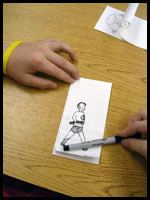| |
|
|||||
| |
||||||
| |
||||||
|
||
Objectives Introduction |
|||
|
|||
Materials Professional and/or student made flipbooks Long strips of paper (2 x 8 inches) for 2-page flipbooks Index cards (at least 10 per student) Pencils, markers Light table (to help view preceding image)(Note: can also use window) Registration devices such as clips or envelope corners |
|||
|
|||
|
|
||
CREATE MULTIPLE PAGE FLIPBOOKS WITH TWEENING
|
|||
Click to View Multiple Page Flipbook Example Evaluation
|
|||
|
|
|||
©
2008 Karin Gunn. All rights reserved. |
|||||||||
